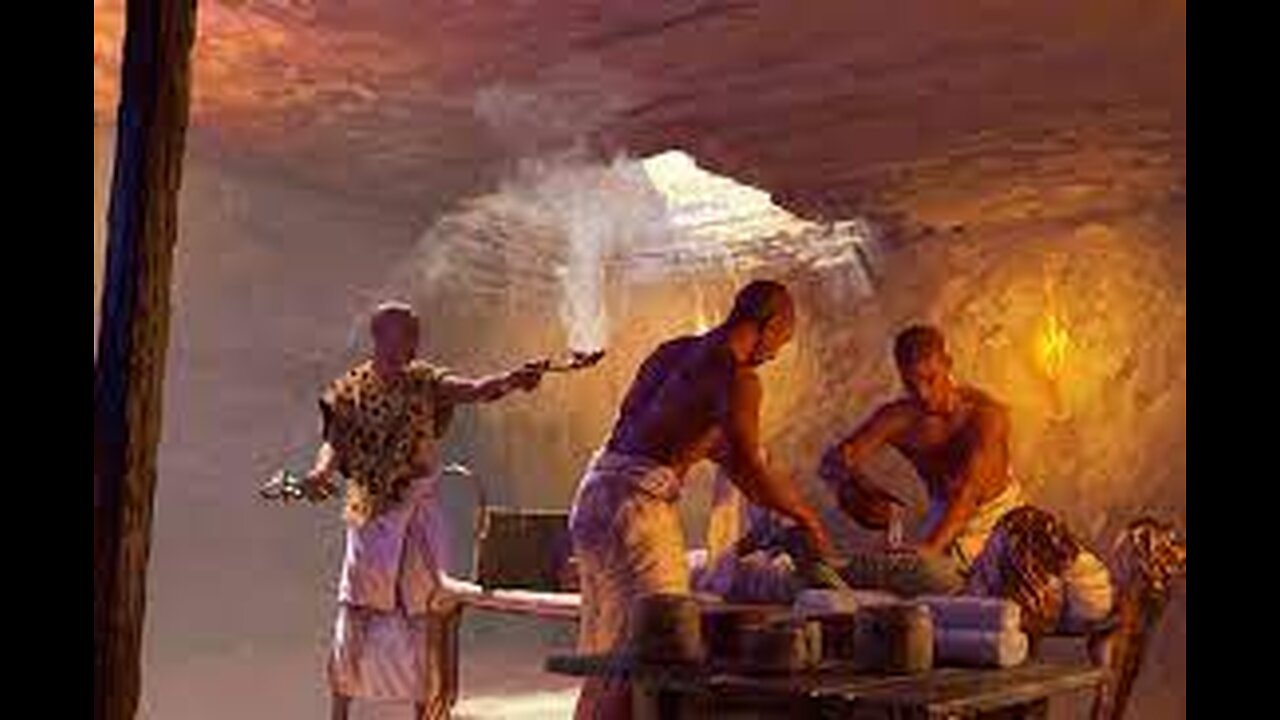Premium Only Content

Secret of the mummies | Ancient secrets.
For the ancient Egyptians, mummification was a spiritual process imbued with deep meaning. Ancient texts show it took 70 days, with carefully defined rituals and invocations, to prepare the deceased for an eternal afterlife. It also required specialized skills, long lists of ingredients, and a professional class of embalmers steeped in religious and chemical knowledge.
But what went into—or was smeared on, brushed over, and wrapped around—the mummified bodies themselves has been mostly guesswork on the part of modern scholars. “There’s almost no textual evidence,” says Philipp Stockhammer, an archaeologist at the Ludwig Maximilian University of Munich. “How this worked, how the substances were mixed, how they were named—this wasn’t known.”
That changes with a study Stockhammer and his colleagues published this week in Nature. By identifying residues from labeled jars found in an ancient Egyptian mummification workshop, the researchers were able to show the process involved complex chemistry and exotic ingredients, including resins sourced from a continent away. “You can actually look into the vessels and see what’s still inside,” says Barbara Huber, an archaeological scientist at the Max Planck Institute for Geoanthropology who was not involved with the research.
The new evidence emerged from a 2700-year-old (664 B.C.E.–525 B.C.E.) burial complex south of Cairo called Saqqara. In 2016, University of Tübingen archaeologist Ramadan Hussein, who died in the spring of 2022, identified shallow aboveground pits where the dead would have been covered in natron, a salt mixture used to dry out the body after death. Partway down a nearby shaft was an underground chamber outfitted with flat stone niches for corpses—a workshop for mummifiers. “It’s the first physical evidence for the places where they worked,” says University of York archaeochemist Stephen Buckley. At the very bottom of the shaft, 30 meters down, were burial chambers.
A body that began the mummification process at the top of the “funeral home” could have been buried directly below, presumably after spending a few weeks being prepared in the underground chamber. “It was a protoindustrial mummification workshop for the upper class,” Stockhammer says.
The shaft had been carefully filled with sand, rocks—and dozens of embalming vessels that seemed to have been ritually disposed of after workers had used them. “They turned it into a hiding place for the tools,” Hussein said in an interview before his death. “We found cups, bowls, plates, and incense burners inscribed with the names of oils and substances u. The researchers used a dentist’s drill to remove coin-size fragments a few millimeters thick from the inside of the containers, then analyzed their chemical makeup using gas chromatography-mass spectrometry. Earlier studies had analyzed mummies from museum collections and identified embalming chemicals including tree resins and bitumen. But this is the first to examine vessels found in the context of a mummification workshop.
a jar from a mummification workshop
The label on a jar from a mummification workshop read “to be put upon his head.”SAQQARA SAITE TOMBS PROJECT/UNIVERSITY OF TÜBINGEN
The analysis revealed traces of animal fats, beeswax, vegetable oils, and bitumen along with multiple plant resins—ingredients that were probably mixed and heated to form ointments. Their properties made them particularly easy to recover from pottery vessels, even after thousands of years. “The more fatty and sticky a residue is, the better results you get,” Stockhammer says. “We had good organic preservation, and we had residues that preserve well.”
After being immersed in natron, corpses were treated with the sticky mixtures to seal the skin, blocking decay and decomposition by bacteria. “The materials we found have an antibacterial function,” Stockhammer says. “It’s the most complicated part of the process, where the chemistry really starts.” Some ointments may have been smeared directly on the corpses; others were probably applied to the linen bandages, which may have been dipped directly into wide-mouthed “goldfish bowl” vessels.
Some of the bowls still had stains on the outside from spills and dripping mummy wrappings. Many also bore labels naming specific ingredients—antiu or sefet—or giving more general descriptions, like “to make his odor pleasant” and “treatment of the head.” “For the first time, you have a direct correlation between text and a specific residue,” Huber says. “I don’t know if there’s a better case study than having them all together.”
The finds may require reassessment of ancient Egyptian texts. The word antiu, for example, appears thousands of times in Egyptian sources, and for more than a century Egyptologists have thought it referred to myrrh, the resin of a particular thorn tree. But vessels labeled antiu at the mummification workshop contained other substances—most notably cedar, sourced at the time from the mountains of Lebanon. “Possibly antiu is just a generic word for resin,” Hussein said before his death. Sefet, described as one of the “seven sacred oils” in many ancient texts, turned out to be a mixture of cypress or juniper resin and animal fat.
The researchers also identified more exotic ingredients, including dammar and elemi, resins extracted from hardwoods native to Southeast Asian rainforests thousands of kilometers from ancient Egypt. Cedar and pistachio, meanwhile, were sourced from around the Mediterranean, and pitch from the Dead Sea. “Almost all the things embalmers needed came from outside Egypt,” Stockhammer says. “And you need a lot of this to mummify and embalm, not just a few grams. Even if it’s just a few thousand individuals a year who are high-status enough to be mummified, it’s still a lot of material. Mummification drove globalization.”The substances themselves may have been selected precisely because they were hard to get. “Some of the materials may have been used not because they were more effective, but because they were exotic—‘Look at the size of my world, that I can get something from so far away,’” Buckley says.
Some scientists caution that the mummification compounds could have degraded and changed over time, throwing off the analysis. “They may have gone a little too far in the interpretation,” says Kate Fulcher, a heritage scientist at the British Museum. “No one’s done a controlled experiment where we’ve aged resin for 3000 years and seen how it’s deteriorated—we don’t know how these [chemical compounds] look after all this time.”
But the chemical artistry behind the pot residues is unmistakable, reflecting precise knowledge of ingredients, temperatures, and cooking times won over hundreds, if not thousands, of years. Ancient Egyptians “spent more than 2000 years trying to perfect the preservation of the human body—that’s 2000 years trying to perfect their workflow,” Stockhammer says. “The chemical knowledge they must have had in this workshop was amazing.”
-
 2:37
2:37
Canadian Crooner
1 year agoPat Coolen | Let It Snow!
15.6K8 -
 2:44
2:44
BIG NEM
10 hours agoWhat's Really Behind the Fake Alpha Male Epidemic?
12.7K4 -
 57:20
57:20
State of the Second Podcast
7 days agoThe Inventor of Bump Stock Fights Back! (ft. Slide Fire)
11.5K4 -
 1:04:12
1:04:12
PMG
1 day ago $11.69 earned"I’ll be DRONED for Christmas!"
44.9K11 -
 23:38
23:38
RealitySurvival
1 day agoBest Anti-Drone Rounds For Self Defense
19K4 -
 57:43
57:43
barstoolsports
17 hours agoBest Shot Wins The Game | Surviving Barstool S4 Ep. 7
214K9 -
 1:52:24
1:52:24
Kim Iversen
13 hours agoLuigi Mangione Charged With TERRORISM | Liz Cheney Accused Of WITNESS TAMPERING, Faces 20 YEARS IN JAIL
114K159 -
 6:50:10
6:50:10
Akademiks
14 hours agoJay Z says he aint NEVER been friends w/ DIDDY! Bhad Bhabie lost her man? Travis Hunter Down Bad?
117K14 -
 2:27:04
2:27:04
AirCondaTv Gaming
12 hours ago $24.12 earnedWar Thunder - Tankering Around for That 10 Bomb
60.6K5 -
 4:19:05
4:19:05
SpartakusLIVE
15 hours agoThe MACHINE locks in for 12-hour POWER stream
45.1K1